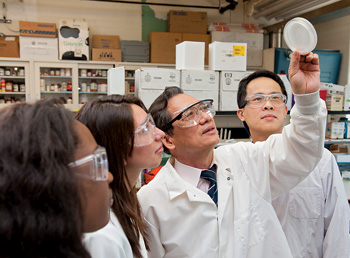New technique removes toxin from drinking water

RESEARCH | We've all gazed, transfixed, as fireworks rained down on the Fourth of July, seemingly right above us. But have you ever wondered about the ash heaped beneath the spent firework launch tube?
The white, powdery material is perchlorate residue, a chemical byproduct found in common fireworks, fertilizer, hazard flares and matches, as well as rocket fuel, munitions and propellants used in the defense industry.
Valued in laboratory experiments because it does not react with many other chemical species in water, perchlorate is an emerging contaminant that is known to interfere with the metabolism of the thyroid gland in humans. Toxic even at low levels, on the order of four parts per billion, perchlorate has affected 15 million people in the United States via contaminated drinking water, according to estimates by the federal Environmental Protection Agency.
Now, an innovative membrane, synthesized in the laboratory of Prof. C.P. Huang, offers a breakthrough development in clean technology to remove perchlorate from water. It is the first attempt to quickly and easily reduce low levels of perchlorate to non-toxic chloride by combining electrodialysis and an electrochemical reaction in one system.
"Conventional electrochemical reduction of perchlorate to chloride is very slow, and requires a low pH, high perchlorate concentration and high temperature," says Huang, Donald C. Phillips Professor of Civil and Environmental Engineering, whose work is funded through a $365,000 grant from the National Science Foundation.
"Our method enables the first concentration of perchlorate at low levels—on the order of a few parts per million (ppm) to a few thousand ppm—to be collected and reduced under ambient conditions, specifically a neutral pH, room temperature and pressure."
S. Ismat Shah, a professor with joint appointments in the Department of Materials Science and Engineering and the Department of Physics and Astronomy, is co-principal investigator on the three-year grant.
Huang and doctoral student Poyen (Kevin) Wang have synthesized the membrane, which is made from inexpensive plastic, to isolate perchlorate from other major anions such as bicarbonate, nitrate and sulfate, in water.
"Most anionic electrolytes are negatively charged. When placed under the influence of electricity, they naturally migrate toward the positively charged side of the membrane, but only perchlorate is able to pass through," Huang says.
The process enables researchers to collect the perchlorate in high concentrations in the reaction chamber, while other major anions remain on the other side of the membrane partition. The accumulated perchlorate is then reduced to non-toxic chloride with a second low-voltage electrochemical current.
Among the membrane's advantages is its ability to rapidly detect perchlorate's presence in water. Huang's goal is to see the technology implemented on the household level to improve the water quality for general consumers or small-scale operations, such as hospitals, schools and offices.
"If we can reduce perchlorate … we can reduce many other contaminants such as nitrate, organic compounds and heavy metals as well," he says.
In the meantime, Huang plans to add valuable data to his study by collecting air samples at Taiwan's annual Beehive festival, held in Tainan City, where millions of fireworks are lit, setting the stage for potentially widespread perchlorate exposure over a short amount of time.
"Off-ground fireworks, like those popularly used in Asian culture, are particularly susceptible to dispersing perchlorate," Huang says. "We estimate that the exposure is five times higher than normal for event participants."
He hopes to document the increased levels of perchlorate to which festival goers are exposed during the event in order to calculate the potential risk to participants.
Article by Karen B. Roberts, AS90





